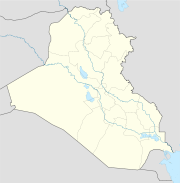- Sippar
-
Sippar und das Umland
Sippar (sumerisch Zimbir, biblisch vielleicht Sepharvaim, heute Tell Abū Ḥabbah) war eine erstmals in Sumer erwähnte Stadt des Altertums und bedeutet: Stadt der Vögel.
Inhaltsverzeichnis
Grabungsgeschichte
Tell Abū Ḥabbah wurde im Dezember 1880 von Hormuzd Rassam besucht und als Sippar identifiziert[1]. Fast sofort nach dem Beginn der Ausgrabungen im Jahr 1881 wurde die Sonnengott-Tafel oder Abu-Habbah Tafel entdeckt, die aus der Regierungszeit von Nabû-apla-iddina stammt [2]. Zwischenzeitlich wurde in Sippar eine große Anzahl von Keilschrifttexten entdeckt.
Geschichte
Sippar lag in etwa 60 Kilometer nördlicher Entfernung von Babylon und 16 Kilometer südwestlich vom heutigen Bagdad auf der östlichen Seite des Euphrat. Die Stadt war zweigeteilt in Sippar des Sonnengotts und Sippar der Ischtar. Der Ort beheimatete als Hauptgott Utu und wurde inschriftlich unter anderem auch Sippar von Eden genannt. Der Tempel des Sonnengottes Schamasch war unter der sumerischen Bezeichnung Ebabbar bekannt. Die zugehörige Inschrift wurde auf das Jahr 1831 v. Chr. datiert.[3]
Siehe auch
Anmerkungen und Einzelnachweise
- ↑ H. Rassam, Recent Discoveries of Ancient Babylonian Cities, TSBA 8, 1885, 172-80
- ↑ M. Jastrow, Jr., On the Assyrian kudiru and the Ring of the Sun-god in the Abu-Habba Tablet. Proceedings of the American Oriental Society at Philadelphia 1888, 95-98; M. Jastrow, Jr., Nebopolassar and the Temple to the Sun-god at Sippar, American Journal of Semitic Literature 15, 1899, 65-86
- ↑ Benjamin Bromberg: The Origin of Banking: Religious Finance in Babylonia in The Journal of Economic History 2, Nr. 1, 1942, S. 77–88.
Literatur
- Robert Rollinger: Von Sumer bis Homer - Festschrift für Manfred Schretter zum 60. Geburtstag am 25. Februar 2004 -, Ugarit-Verlag 2005, ISBN 3-934628-66-4
Kategorien:- Sumer
- Babylonien
- Archäologischer Fundplatz im Irak
Wikimedia Foundation.

